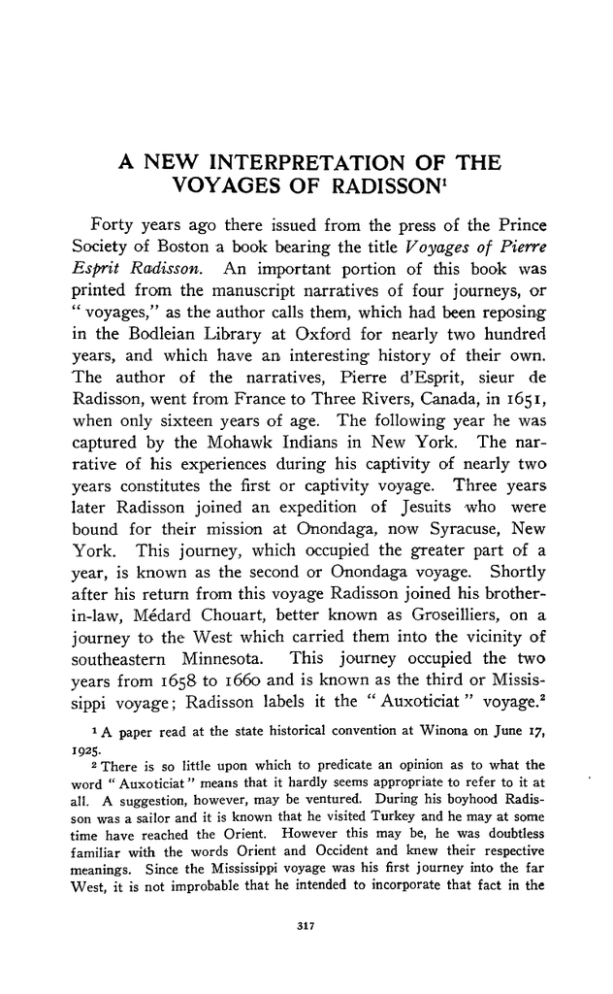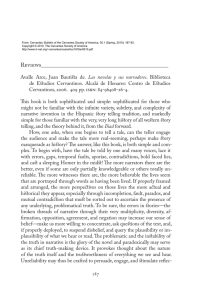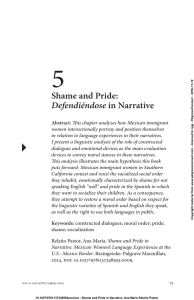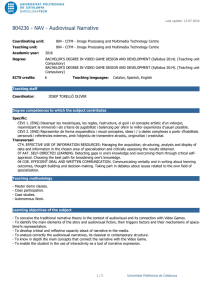A new interpretation of the voyages of Radisson.
Anuncio

A NEW INTERPRETATION OF THE VOYAGES OF RADISSON* Forty years ago there issued from the press of the Prince Society of Boston a book bearing the title Voyages of Pierre Esprit Radisson. An important portion of this book was printed from the manuscript narratives of four journeys, or " voyages," as the author calls them, which had been reposing in the Bodleian Library at Oxford for nearly two hundred years, and which have an interesting history of their own. The author of the narratives, Pierre d'Esprit, sieur de Radisson, went from France to Three Rivers, Canada, in 1651, when only sixteen years of age. The following year he was captured by the Mohawk Indians in New York. The narrative of his experiences during his captivity of nearly two years constitutes the first or captivity voyage. Three years later Radisson joined an expedition of Jesuits who were bound for their mission at Onondaga, now Syracuse, New York. This journey, which occupied the greater part of a year, is known as the second or Onondaga voyage. Shortly after his return from this voyage Radisson joined his brotherin-law, Medard Chouart, better known as Groseilliers, on a journey to the West which carried them into the vicinity of southeastern Minnesota. This journey occupied the two years from 1658 to 1660 and is known as the third or Mississippi voyage; Radisson labels it the " Auxoticiat" voyage.^ 1 A paper read at the state historical convention at Winona on June 17, 1925- 2 There is so little upon which to predicate an opinion as to what the word " Auxoticiat" means that it hardly seems appropriate to refer to it at all. A suggestion, however, may be ventured. During his boyhood Radisson was a sailor and it is known that he visited Turkey and he may at some time have reached the Orient. However this may be, he was doubtless familiar with the words Orient and Occident and knew their respective meanings. Since the Mississippi voyage was his first journey into the far West, it is not improbable that he intended to incorporate that fact in the 317 3i8 ARTHUR T. ADAMS DEC. One year later the brothers again went west, reaching Minnesota and the region of Lake Superior, and after two years they returned, in 1663, to their home at Three Rivers. This was the fourth or Superior voyage. Oh both western voyages they traversed the same route up the Ottawa River to Georgian Bay. The Mississippi voyage took them through Lake Michigan and Green Bay, and they finally reached the region around the present sites of Hastings and Red W i n g ; and on the Superior voyage they skirted the south shore of Lake Superior tO' Chequamegon Bay, and reached their destination, the " rendezvous," probably in the region of Kanabec County, near the site of Mora. They returned home on each voyage by way of the Ottawa River. However interesting the events of these voyages may be, they lie outside the scope of this paper. The present inquiry is concerned only with the character and peculiarities of the Radisson narrative. Radisson, according to his own account, made his four voyages during the years between 1652 and 1663, in the following order: the captivity voyage, from title of his narrative. It is indeed a far cry from " occidental" to " Auxoticiat," but in view of Radisson's deficiency in the use of the English language, as evidenced by such names as "Octanac" (Ottawa), " Poutouatemick" (Potawatomi), " Escotecke" (Mascoutin), "Columest" (Calumet), and many other Indian names, one may hazard the guess that his word " Auxoticiat" is the result of a desperate and harrowing effort to express occidental. If so, the word is not destitute of meaning and appropriateness in the following title of the journal of the Mississippi voyage: " Now followeth the Auxoticiat Voyage into the Great and filthy Lake of the Hurrons, Upper Sea of the East, and Bay of the North.'' See Voyages '. of Peter Esprit Radisson, Being an Account of His Travels and Experiences among the North American Indians, from 1652 to 1684, 134 (Boston, 1885). For the history of the Radisson narrative of the travels from 1652 to 1664, see page 22 of the same work. A. T. A. Perhaps " Auxoticiat" is the result of a •' desperate and harrowing effort" by a copyist to reproduce a strange word in Radisson's handwriting. It should be noted that at the end of the account of Radisson's third voyage the following line occurs: " The ende of the Auxotacicac voyage, wcl» is the third voyage." Are both " Auxoticiat" and "Auxotacicac" copyist's versions of occidental? Ed. I92S THE VOYAGES OF RADISSON 319 1652 to 1654; the Onondaga voyage, from 1657 to 1658; the Mississippi voyage, from 1658 to 1660; and the Superior voyage, from^ 1661 to 1663. It will be noticed that between the captivity and Onondaga voyages there is a vacant period of three years. During the first two of these three years a journey was made into the West by two unnamed Frenchmen. This journey, which is mentioned in the Jesuit Relations, is involved in a controversy which arose shortly after the publication of Radisson's Voyages and has not yet been settled.^ This unwritten voyage is a material element in the present discussion; the captivity voyage, however, has nO' significance in connection with this argument and will not be again considered. It is now necessary to consider three significant points regarding these voyages: ( i ) the account given in the Jesuit Relations of the unwritten voyage of 1654 to 1656 is similar in many respects to Radisson's narrative of the Mississippi voyage;* (2) there is no record of the doings or whereabouts of Radisson and Groseilliers during the period of the unwritten voyage; (3) near the end of the Superior voyage, in 1663, Radisson relates the story of the Dollard massacre, stating that his party came to its scene eight days after it occurred.^ The Dollard massacre was one of the most tragic events in the history of Canada. It occurred in May, 1660, near the Long Sault or Ottawa Rapids, where a handful of French and Algonquins under Adam Dulac were overcome by a force of six hundred Iroquois after a heroic resistance of five days. Because of these coincidences and discrepancies, some writers have modified Radisson's schedule. The Mississippi voyage is moved back to the position of the unwritten voyage; thus they are made identical and it is assumed that the the two unnamed Frenchmen were Radisson and Gro^ Reuben G. Thwaites, ed., The Jesuit Relations and Allied Documents, 42:219-223 (Cleveland, 1899). * Radisson, Voyages, 134-172. 5 Radisson, Voyages, 232-235. 320 ARTHUR T. ADAMS DEC. seilliers. This creates a vacancy for the years 1658 to 1660. The Superior voyage is now moved back to that position, and the Dollard story is thus put in its proper historic place, 1660. It will also be noticed that the Mississippi voyage is now followed by a vacant year just as it was before, thus adding to the plausibility of this construction. Remarkable coincidences! A plausible solution! But what is the effect upon Radisson's narrative? It must be remembered that the journal of all four voyages is one continuous narrative, the end of each blending intO' the beginning of the next, and the beginning of each referring back to the end of the preceding voyage. Thus the shifting of the voyages completely breaks asunder the order in Radisson's own story at every point of contact and does great violence to his own schedule. Such construction seems to do' injustice to the author of the journal; and the purpose of the present paper is to put forward another solution of the problem. In order to understand the writer's attempt to solve this enigma it is necessary to give attention to certain particulars of the third or Mississippi voyage. The narrative of thisvoyage occupies about thirty-eight pages of the printed book and may be conveniently divided into three distinct sections. The first section of twenty-four pages' covers the outward journey from the explorers' home at Three Rivers to their destination, which Radisson calls the " First Landing Isle," and which has been identified by some writers as Prairie Island in the Mississippi River between Hastings and Red Wing. The second section describes the sojourn at the Landing Isle. It consists of only fifteen lines and in the present article is referred to as the Landing Isle paragraph. The third section is the narrative of the return journey fromi the Landing Isle to Three Rivers and occupies about thirteen pages. In the first section the journey of the voyageurs to the interior is related; they leave Three Rivers, go up the Ottawa River, cross Lake Nippissing, descend the French River, cross Georgian Bay and the north ends of Lakes Huron and Michi- 1925 THE VOYAGES OF RADISSON 321 gan, and thence go down Green Bay and up the Fox River to the country of the Mascoutens. From here, according to the narrative, they make an extended tour of nearly a year into the South, reaching a country of which Radisson says " it never snows nor freezes there but mighty hot." After an apparent omission in the narrative they are again in the region of Green Bay. After spending the winter among the Salteurs, or (Hiippewa, in northem Wisconsin or Michigan they journey across a country almost fifty leagues on snowshoes, reaching a riverside. Canoeing thence up the river some ten or twelve days they arrive at the First Landing Isle, where they find Huron Indians who had been driven west by the Iroquois. They endeavor to induce these Hurons to go back to Canada with them, but the Indians refuse to go because of their fear of the Iroquois back on the Ottawa River. Thus the travelers' efforts to return to Canada that year appear to be frustrated; and here ends the first section of the narrative, the account of the outward journey." Immediately following this is the second section of the narrative, the Landing Isle paragraph of fifteen lines. The first sentence of this paragraph should be carefully noted: " Y ' summer I went a hunting, & my brother stayed where he was welcome & putt up a great deale of Indian corne that was given him."' To state it in simpler form: That summer I went a hunting and my brother stayed at the Landing Isle. In yet other words, the twO' brothers parted company at this time and place and were separated for a few months. The remainder of the Landing Isle paragraph describes the events occurring on the isle during Groseilliers' sojourn there. One would naturally expect to find Radisson's description of his own experiences on the four months' hunting journey immediately following the Landing Isle paragraph. But it is not there, and just at this point is the mystery that has confused historians for the past forty years. 8 Radisson, Voyages, 134-158. •^ Radisson, Voyages, 158. 322 ARTHUR T. ADAMS DEC Radisson describes his hunting journey, but strange to say, this story is curiously hidden away in a most unnatural and inappropriate part of the third section of the narrative — that which tells of the return journey.* Near the end of the narrative of the return journey is a vivid description of a battle with the Iroquois while the voyageurs were passing the rapids of the Ottawa River not far above Montreal. At this point in the river a carriage (portage) was usually made, but in order to make more haste and overtake the fleeing Iroquois, Groseilliers attempted to shoot the rapids, with the result that his boat overturned and he and his Indian companions came to shore.' At this point the narrative abruptly stops and the hunting story, which describes Radisson's experiences earlier in the summer back in the region of the Mississippi River, begins. Immediately following this hunting story is the phrase " To our purpose " — the key to the mystery.^" Then follows a continuation of the description of the battle in the rapids and an account of the travelers' final arrival at Quebec. Nothing could be more obvious to the reader of the narrative than the fact that the hunting story is out of its proper place, whatever the cause, and must be removed. In removing the hunting story, however, two things must be borne in mind: the phrase " To our purpose " is to remain where it is, and the gap made by the removal is to be left open. Now that the hunting story has been taken out, where shall it be reinserted? Naturally, and by the first principle of documentary construction, immediately after the Landing Isle paragraph. The account must be so' construed as tO' give each part a reasonable, logical, and consistent meaning. As noted, the first sentence of this paragraph is, " Y* summer I went a hunting, & my brother stayed " at the Landing Isle. In describing the experiences of each during the same period of time but in different localities Radisson did what any other ^ Radisson, Voyages, 167-169. ' Radisson, Voyages, 167. 1" Radisson, Voyages, 169. 1925 THE VOYAGES OF RADISSON 323 narrator must do — he related the events in one locality and followed this with a relation of the events in the other. It would not be practicable to combine the two in one composite narrative. In determining the proper place tO' reinsert the hunting story one is not limited to rules of construction, however. The context itself determines the matter. It will be observed that the last words of the Landing Isle paragraph relate to the sickness of Groseilliers. The last words of the hunting story also relate to the sickness of Groseilliers, but they include the very significant clause " As I said before." ^^ Now since these are the only references to Groseilliers' sickness in the entire journal it is obvious that the hunting story cannot precede the end of the Landing Isle paragraph, or the clause " As I said before" would have no meaning. The remainder of the journal deals with the return journey and forms a consistent and continuous narrative from beginning to end. The hunting story is already improperly interpolated in the account of the return journey and in any other part of this account it would be equally out of place. The conclusion is that the hunting story must be reinserted just after the Landing Isle paragraph, that is, at the division point between this paragraph and the account of the return journey. By this change the narrative becomes at this point clear, consistent, and logical. Attention must now be directed to the Superior voyage, which ended in 1663, according to Radisson. It will be remembered that near the end of the narrative of this voyage there is inserted the story of-the Dollard massacre, which is 11 Groseilliers' sickness is described as follows at the end of the Landing Isle paragraph: " My brother fell into the falling sicknesse, & many weare sorry for it. That proceeded onely of a long stay in a new discovered country, & the idlenesse contributs much to it. There is nothing comparable to exercise. It is y^ onely remedy of such diseases. After he languished awhile God gave him his health againe." At the end of the hunting story, Radisson tells of his companion's misfortune t h u s : " When I came backe I found my brother sick, as I said before. God gave him his health, more by his courage then by any good medicine, ffor our bodyes are not like those of the wildmen." Radisson, Voyages, 158, 169. 324 ARTHUR T. ADAMS DEC known to have occurred in May, 1660. At this point it becomes necessary to digress for a moment from the line of argument and take note of a very significant characteristic of Radisson's style. Perhaps all students of Radisson's Voyages have observed a marked tendency in the author to digress from his subject and narrate events irrelevant to his voyage. When Radisson does so digress, he relates a sharp, clean-cut story, the digression is usually introduced by appropriate words, and at its end the main narrative is reintroduced by another appropriate expression. A few examples will tend to establish this important point. In his first or captivity voyage, after describing a feast given by his foster father following a successful war expedition, Radisson closes the digression with the words, " But to the purpose of my history." A little later in his narrative of the same voyage he abruptly stops and says: " I prolong a litle from my purpose of my adventure," and continues with a description of Iroquois cruelties that leaves little to the imagination. The main story is reintroduced by the following words: " now lett me come to our miserable poore captives that stayed all along [through] the raine upon the scaffold." Near the beginning of the Onondaga voyage Radisson digresses to give a history of the Huron Indians, beginning, " It will not be amisse to leave the following of y® voyage " ; then follow several pages of Huron history closing with the words: " Lett us come to our purpose and follow our voyage," and the main narrative is resumed. At the end of the Superior voyage a description of the religious beliefs of the Indians is given beginning with these words: " Before I goe further I have a mind to let you know the fabulous beleafe," and here follow several instructive pages, closing thus: " But let us come tO' our arrivall againe." Then follows the relation of the unpleasant conference between the voyageurs and the governor.^^ There are numerous other examples of similar digressions, but let us again come to the purpose of the argument. 12 Radisson, Voyages, 41, 52, 54, 87, 95, 236, 240. 1925 THE VOYAGES OF RADISSON 325 The hunting story is an integral part of the narrative. It describes Radisson's own experiences and is not a digression, hence, it is not introduced by special words and should not be followed by the phrase " To our purpose," as we find it in its original position. The Dollard story is decidedly a digression, being introduced by the words: " Y o u must know that 17 ffrench made a plott," but there is no appropriate expression at the end of this digressive story to reintroduce the main narrative, as would be expected. It will be recalled that the hunting story is found in the Mississippi voyage in the midst of the description of the explorers' passage through the Ottawa Rapids, where a portage was usually made. It is a striking coincidence that the Dollard story is found in exactly the same relative place in the narrative of the Superior voyage, ending three years later. It should be remembered that on both voyages Radisson and Groseilliers returned by way of the Ottawa River and passed through the rapids. Since the Dollard massacre occurred in 1660 it is evident that the narration of it in the Superior voyage is out of its proper place by three years.^' If the Dollard story is taken out of the narrative of the Superior voyage and placed three years back in the vacancy left by removing the hunting story from the account of the Mississippi voyage, it will then be followed by the phrase " To our purpose," since that phrase was left in its original position. It will now be observed that the Dollard story appears in the midst of the account of the passage through the rapids as before, but as a digression, properly introduced and followed by the reintroductory words " To our purpose," as has been found to be Radisson's custom. 13 Dr. Benjamin Suite, in a study entitled " Radisson in the Northwest, 1661-63, " published some twenty years ago, declares that the Dollard passage " is not in its proper place," and in his " Decouverte du Mississipi en 1659" he suggests that Radisson may have confused 1663 with 1660. H e dates the first and second western voyages 1658-60 and 1661-63 respectively. Royal Society of Canada, Proceedings and Transactions, 1903, section i, p. 39, 40; 1904. section 2, p. 238. Ed. 326 ARTHUR T. ADAMS DEC Another point bearing on our problem of interpretation is found in Radisson's use of the word " backe " in the clause " we came backe to our carriage " which immediately follows the phrase, " T o our purpose." If the hunting story be left in its original place the word " backe " has no meaning, since there is nothing to imply or suggest that the explorers had been away from their carriage. But if the last words of the transposed Dollard story, namely, " Wee visited that place and there was a fine Fort; three were about y^ other two," are noted, it will be seen at once that this word " backe " has a definite meaning. Upon coming to shore after the capsizing of GroseiUiers' boat the voyageurs visited the scene of the recent massacre and of course they " came backe to their carriage." One point remains to be considered in the interpretation of Radisson's journal. What is the effect of removing the Dollard story from the account of the Superior voyage and closing the gap? If, after this is done, this part of the narrative is carefully read, it will be noticed that while Radisson and Groseilliers expected a battle with the Iroquois as was usual at this point in the Ottawa, they did not see a single Iroquois in all their journey down the Ottawa to Montreal. This is in accord with historic facts. While the Iroquois gave the French settlements a great deal of trouble during the decade from 1655 to 1665, and were especially aggressive at the Long Sault, there was a lull in their activities during the summer of 1663. This was probably due to the effects of a severe earthquake in February of that year, which had a sobering effect on all the inhabitants, both French and native, and also to the fact that the Iroquois, during that sumrner, were meeting with severe reverses in their wars with neighboring tribes and thus required all their fighting strength elsewhere than on the St. Lawrence.^* 1* William Kingsford, A History of Canada, 1:312 (Toronto, 1887); Francis Parkman, The Old Regime in Canada, i : 183-187 (Frontenac edition, Boston, 1907). 1925 THE VOYAGES OF RADISSON 327 To summarize, two transpositions have been suggested which would affect the narrative at three points: ( i ) If the hunting story is inserted immediately after the Landing Isle paragraph the narrative at this point becomes logical and consistent, and the transposition is strictly in accord with the principles of documentary construction and the requirements of the context. (2) If the Dollard story is placed in the gap created by the removal of the hunting story the resultant narrative is consistent, logical, and historically correct, and it is handled in accordance with Radisson's custom and in compliance with the needs of the context. (3) The removal of the Dollard story from the Superior voyage and the closing of the gap are steps which leave the narrative at this point consistent, logical, in correct diction, and in harmony with the facts of history. T o sum up the matter, the writer advances the theory that Radisson and Groseilliers made all three of the western voyages ^ - the unwritten, the Mississippi, and the Superior — and that the journal of the Mississippi voyage is, in fact, a composite narrative of both that voyage and the unwritten voyage. This theory is supported by abundant evidence and clarifies to a remarkable degree the ambiguities and apparent inconsistencies of the entire journal. The writer believes that the four voyages narrated in Radisson's journal took place in the exact order and during the exact periods of time that the voyageur himself asserts. In the light of this theory the journal of Radisson must be considered a truthful, reliable, and valuable source of American history. It should be noted in closing that there are not a few other problems involved in the interpretation of the Radisson journal, some of which are closely related to the matters discussed in this paper. A few of these problems may be stated. ( i ) Radisson asserts explicitly in two places and implies in others that the Mississippi voyage continued three years.^° The facts of history and also the context of his own narrative make this 1= Radisson, Voyages, 134, 157, 170. 328 ARTHUR T. ADAMS DEC impossible and fix the period at two years.^* ( 2 ) The first nineteen lines of the Onondaga voyage should be the last lines of the preceding, or captivity voyage. At the end of these nineteen lines the author leaps across a period of three years in passing from one sentence to the next, apparently without noticing the inconsistency.^' ( 3 ) Where was Groseilliers on May 3, 1662? According to the Jesuit Relations he passed Quebec on his way tO' Hudson Bay.^' According to Radisson he was in the vicinity of the west end of Lake Superior. (4) Did Radisson and Groseilliers make the journey to the South on the Mississippi voyage? ^° (5) Did they make the journey to Hudson Bay on the Superior voyage? ^'' (6) Were they the first white men tO' reach the upper Missis18 Dr. Louise Phelps Kellogg has advanced the interesting theory that Groseilliers went west in 1654, but that Radisson did not go with him. Radisson, she suggests, may at that time have been in France. Groseilliers returned in 1656 and may then have induced Radisson to accompany him to the West for a year to trade with the Indians. In Dr. Kellogg's opinion, this supposition would explain Radisson's description of the journey of 1656 as his first introduction to the West. It would also make clear his assertion that the voyage lasted three years, " since he was describing both his own and Groseilliers' adventures." Dr. Kellogg's views are brought out in an article entitled " T h e First Traders in Wisconsin,'' published in the Wisconsin Magazine of History, 5:348-359 (June, 1922). Attention may also be directed here to Dr. W a r r e n Upham's monograph entitled " Groseilliers and Radisson, the First White Men in Minnesota, 1655-56, and 1659-60, and Their Discovery of the Upper Mississippi River," in the Mmnesota Historical Collections, 10:449-594 (part 2 ) . Appended to this study is a valuable bibliography listing more than one hundred books and papers. This furnishes a good guide to the opinions of scholars on the Radisson question, for the titles are followed by brief, compact summaries of the views of the respective authors. Dr. Upham gives some attention in his monograph to the question of the Radisson manuscripts and their handwriting. This phase of the subject would appear to deserve further study and it is hoped that when a new edition of the voyages is brought out, based on the originals, a searching analysis of the manuscripts will be made. Ed. 1' Radisson, Voyages, 86. The break occurs between the sentence ending " I stayed not long in a place " and that beginning " The yeare before." 1^ Jesuit Relations, 47 : 279. 1^ Radisson, Voyages, 150-153. 2° Radisson, Voyages, 222-227. 1925 THE VOYAGES OF RADISSON 329 sippi? ( 7 ) Radisson asserts that he cooked eggs in the sand by the heat of the sun on the shore of Hudson Bay, near the Arctic Circle. Is it possible? " ( 8 ) W h y is the Mississippi voyage so filled with errors and ambiguities while all of the other narratives are comparatively free from them? ( 9 ) Why is the Landing Isle paragraph so brief? The theory brought forward in the present paper points the way to the solution of many of these troublesome problems. A R T H U R T . ADAMS M I N N E A P O L I S , MINNESOTA 21" I must professe I wondred that the winter there was so cold, when the sand boyles att the watter side for the extreame heate of the sun. I putt some eggs in that sand, and leave them halfe an houre; the eggs weare as hard as stones.'' Radisson, Voyages, 225. Dr. Upham, in Minnesota Historical Collections, 10:511 (part 2), asserts that this statement "brands the whole story of the travel to Hudson bay as false." The fact that the heat of the Arctic summer can be extreme, however, is proved by statements in the Jesuit Relations, 46:279, 281; in John Oldmixon, The British Empire in America, 1:547 (London, 1741) ; in Jean-Henri Fabre, This Earth of Ours, 67-69 (New York, 1923) ; and in Vilhjalmur Stefansson, The Friendly Arctic, the Story of Five Years in Polar Regions, 15 (New York, 1922). Copyright of Minnesota History is the property of the Minnesota Historical Society and its content may not be copied or emailed to multiple sites or posted to a listserv without the copyright holder’s express written permission. Users may print, download, or email articles, however, for individual use. To request permission for educational or commercial use, contact us. www.mnhs.org/mnhistory




